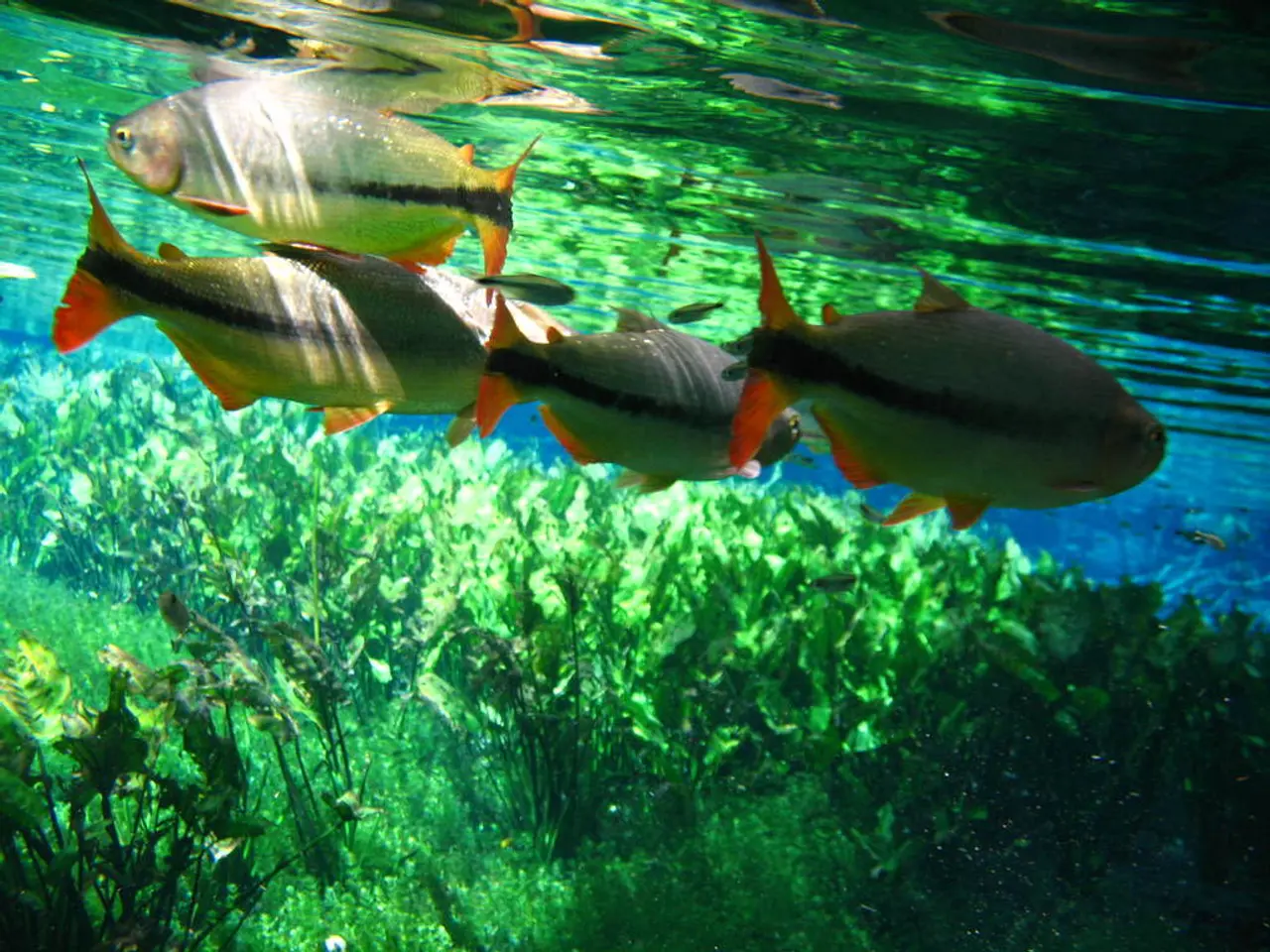Guide to Enhancing Income, Nourishment, and Ecological Aquatic Farming Through Common Carp Cultivation
In the heart of India's agricultural landscape, a simple yet profitable model is gaining traction - Common Carp Farming. This traditional practice, with its modern twists, offers a sustainable and lucrative opportunity for farmers across the country.
The process of common carp farming is a meticulous journey, consisting of several key stages: broodstock selection, breeding (natural and artificial), nursery and fry rearing, pond preparation, fingerling production, and grow-out and harvest.
Broodstock Selection
The foundation of any successful common carp farm lies in the selection of healthy, disease-free, and genetically pure mature carp as broodstock. Genetic purity is paramount to avoid performance and health issues. In advanced farms, broodstock vaccination is practiced to prevent disease outbreaks, such as Koi herpesvirus (KHV).
Breeding
Breeding can occur naturally in well-prepared ponds during the spawning season, or through hormone-induced spawning, egg and milt collection, and fertilization in controlled conditions for better hatchery yield. Cement tanks or controlled hatchery environments are often used for incubation and early fry rearing to reduce natural mortality and predation compared to earthen ponds.
Nursery and Fry Rearing
After hatching, the fry are moved to nursery ponds or tanks, where they are reared under controlled feeding and water quality management. Good nursery management is crucial to increase survival rates. Feeding typically consists of natural food supplemented with formulated feed.
Pond Preparation
Before stocking fingerlings, ponds are drained, dried, limed to stabilize pH, and fertilized with organic matter or manure to boost natural food production such as plankton. Water quality parameters like pH (ideal 6.5–8.5), dissolved oxygen (>5 ppm), and temperature (25–32°C) must be monitored monthly to ensure optimum fish growth.
Fingerling Production and Stocking
Fingerlings are reared until they reach an appropriate size for stocking in grow-out ponds. Farmers may buy certified disease-free fingerlings from hatcheries or produce their own through the described breeding process. When stocking, acclimatization involves floating seed bags on pond water for 20-30 minutes to reduce stress. Stocking densities vary depending on monoculture or polyculture systems, farming goals, and pond conditions; for common carp, densities typically range from 1,000 to 1,500 fingerlings per acre in polyculture setups.
Grow-out and Harvest
In the grow-out phase, fingerlings are reared for 6–10 months depending on species and environmental conditions until they reach market size. This phase requires regular feeding, checking water quality, disease prevention, and pond maintenance. Aerators may be used during summer to maintain oxygen levels. Harvesting usually involves draining ponds or using nets to collect mature fish.
Advanced operations include structured daily routines covering feeding plans, water quality analysis, disinfection, and close farm monitoring. Disease prevention strategies like vaccination and dedicated hatcheries improve fry survival and farm productivity.
This comprehensive approach—from broodstock management through harvest—ensures efficient common carp production with high survival and growth rates in both natural and semi-intensive culture systems. Fingerlings are reared for 2 to 3 months in larger ponds until they reach 100-150 mm in size. Common carp reaches a size of 2.5 to 3.5 kg within 10 to 14 months, with the ideal market size between 1.2 to 1.8 kg.
The depth of the pond for fingerling production should be 1.5-2 m, and stocking density is kept around 1 lakh per hectare. Feed fingerlings twice a day with a mix of rice bran and oil cakes in a 1:1 ratio, supplemented with fishmeal or vitamin-mineral mix.
Grass carp, a herbivorous fish valued in aquaculture for its dual benefits, is another species that finds a home in Indian common carp farming. The practice offers a promising future for sustainable aquaculture, contributing to food security and rural livelihoods.
- In advanced common carp farms, genetic purity is prioritized in the broodstock selection process to prevent health and performance issues, including the use of broodstock vaccination to prevent disease outbreaks like Koi herpesvirus (KHV).
- Breeding methods can be natural in prepared ponds during the spawning season or controlled through hormone-induced spawning, egg and milt collection, and fertilization in cement tanks or hatchery environments for better hatchery yield.
- After hatching, fry are moved to nursery ponds or tanks for rearing under controlled feeding and water quality management, with good nursery management crucial to increase survival rates.
- Before stocking fingerlings, ponds are prepared by draining, drying, liming, manure fertilization, and monitoring water quality parameters like pH, dissolved oxygen, and temperature to ensure optimum fish growth.
- In the home-and-garden section of a lifestyle magazine, one might find recipes for preparing common carp dishes made with fresh fish caught from a home-based common carp farm, along with suggested food-and-drink pairings, fashion-and-beauty tips, and nutrition information on the health benefits of consuming fish like common carp as part of a balanced diet.




